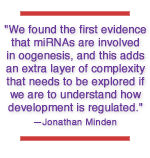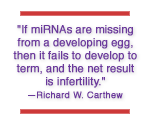|
|
|||||
|
|
Researchers Find MicroRNAS Play Vital Role in Development
Specifically, the miRNAs regulate egg production in a process called oogenesis. MiRNAs silence genes by binding to genetic elements called messenger RNA and preventing them from making new proteins—the molecules primarily responsible for cell activities.
While previous research has identified some miRNA targets, investigators haven't previously seen how miRNAs impact developmental processes.
"We found the first evidence that miRNAs are involved in oogenesis, and this adds an extra layer of complexity that needs to be explored if we are to understand how development is regulated," said Jonathan Minden, associate professor of biological sciences at Carnegie Mellon and one of the paper's authors.
"If miRNAs are missing from a developing egg, then it fails to develop to term, and the net result is infertility," said lead author Richard W. Carthew, Owen L. Coon Professor of Molecular Biology at Northwestern. "It is intriguing to think that miRNA dysfunction might be at the root cause of certain forms of infertility. We already know that miRNAs are involved in cancer and stem cell biology."
Investigators were initially surprised to find that miRNAs affected only a small fraction of expressed genes within a maturing egg. On closer inspection, they found that the genes affected by miRNAs shared common roles as regulators of protein manufacturing or turnover. These results suggest that miRNAs tightly control the abundance of proteins throughout the process of oogenesis and fertilization.
Using a proteomics tool developed at Carnegie Mellon, the scientists compared maturing fruit fly eggs. One group of eggs was missing a gene essential for producing miRNAs, whereas another group of eggs had normal miRNA production. (All plants and animals have DICER, the gene that produces miRNAs, so the researchers used a "genetic trick" to generate DICER-less eggs.)
The investigators also found that miRNAs appear to attenuate protein turnover. They speculate that this function may allow a developing egg to accumulate large amounts of specific proteins necessary to drive the amazing structural changes seen in embryogenesis.
In addition to Carthew and Minden, other authors on the PNAS paper are Christin Sciulli and Susan Dowd of Carnegie Mellon and Kenji Nakahara and Kevin Kim of Northwestern.
The research was supported by the National Institutes of Health.
Lauren Ward, Carnegie Mellon |
|||
|
Carnegie Mellon Home |
|||||
 Jonathan Minden
Jonathan Minden The findings will be published online this week by the Proceedings of the National Academy of Sciences (PNAS) at http://www.pnas.org/.
The findings will be published online this week by the Proceedings of the National Academy of Sciences (PNAS) at http://www.pnas.org/.
 In comparing overall protein production between these two groups, the researchers discovered that miRNAs stopped the manufacturing of a small group of key proteins, including ones that produce ribosomes. These structures constitute the cell's protein-making machinery, and their shutdown would render cells unable to produce new proteins.
In comparing overall protein production between these two groups, the researchers discovered that miRNAs stopped the manufacturing of a small group of key proteins, including ones that produce ribosomes. These structures constitute the cell's protein-making machinery, and their shutdown would render cells unable to produce new proteins.